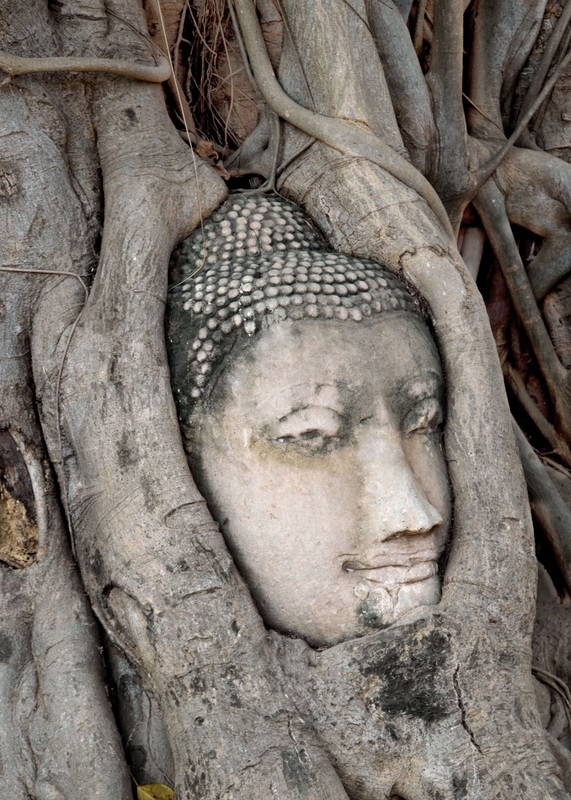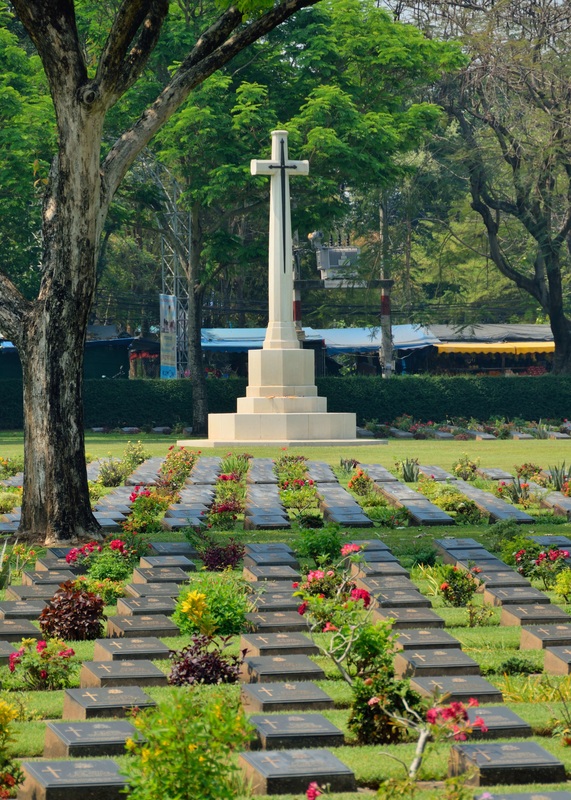|
Located at the confluence of the Chao Phraya and Pa Sak Rivers, the ancient city of Ayuttaya is approximately 50 miles (80 km) north of Bangkok and is often visited as a day trip. Ayuttaya was the second capital of the Kingdom of (Siam) Thailand and existed as such from 1351 until 1767 when it was invaded and sacked (for the second time) by the Burmese. During this port city’s peak, it was an important international center on the trade route between India and China. In 1767 Siam’s capital was moved to what is now Bangkok, the former kingdom was essentially abandoned.
The remaining 700 acres (289 ha) of ruins now exist as the Ayuttaya Historical Park, a UNESCO world heritage site. The park contains a number of Buddhist monasteries, prang and statues spread out between beautiful tree covered green spaces and canals. The most iconic, most visited and most photographed Buddha images are located at Wat Mahathat, a tour bus favorite. Here you will find the large banyan tree with the head from a statue of Buddha embedded in its roots. Wat Mahathat and Wat Rajaburana (to the north) were probably the area's most important Buddhist centers. A large collection of artifacts, many made from gold and precious stones, have been excavated from both sites. Many of these antiquities are displayed at the Chao Sam Phraya National Museum. The museum is a great place to view the work of skilled artisans and learn about the monastic life and history of the Kingdom. Across the street from the National Museum is the Ayuttaya Historical Study Center. This museum’s displays focus more on the city’s secular history and affairs. Visiting both of these museums will provide a tremendous amount of information on the ancient capital while providing an escape from the mid day tropical heat. I made a brief trip to Ayuttaya in 2013 and have contemplated a return ever since. Besides revisiting the temples I wanted to see the remains of the Portuguese and Dutch settlements located to the south of the city. The museum at the former headquarters of the Dutch East India Company, Baan Hollanda, is particularly impressive and should not be missed. Since my trip to Sri Lanka I have become very interested in the history of this institution which was once known by the acronym VOC. Operated by masters of navigation, seamanship and trade, it was basically the world’s first publicly traded corporation. Ayuttaya is a popular stop on a well worn traveler’s path which includes Bangkok, Kanchanaburi and Chiang Mai in the north. Many people opt to take a tourist mini van from Kanchanaburi to Ayuttaya and then connect with the over night train to Chiang Mai. The mini van is a good choice; the 01:30 PM departure time coincides with departure of the north bound train and provides door to door service. From Ayuttaya it is also possible to take a train to Thailand’s north eastern region of Isan. My plan is to take this train to Khorat, Issan's gateway, and work my way to Surin. From Surin I will head to Chong Chom and cross the Cambodian border. There are a number of Angkor era temple complexes between Khorat and Cambodia and I’m looking forward to seeing as many as possible. Until next time, Mike Pollock I had been planning on making a trip to Kanchanaburi for some time. My first idea was to do an organized bus trip from Bangkok, a day trip which is offered by many travel agencies. Fortunately an old friend of mine suggested that I take the train from Bangkok and stay a few days. I’m so glad that I took his advice; Kanchanaburi is a charming little town with many things to do and see. Kanchanaburi is best known for its proximity to the Bridge over the River Kwai and the infamous Thailand–Burma Railway also known as the death railroad. During the World War II Japanese occupation of Thailand and Burma a railway was constructed to connect Bangkok and Rangoon. Approximately 61,000 allied POWs and 250,000 Asian Laborers were involved in the project which started June 1942 and was completed in October 1943. It has been estimated that 16,000 American, Australian, British and Dutch POWs and 90,000 Asian Laborers died during construction. Conditions on the work site were brutal, thousands of men died from malnutrition, disease and exhaustion. Many more were executed or beaten to death by their Japanese and Korean guards. A fantastic way to learn about the railway and the unfortunate souls who built it is to visit the Thailand – Burma Railway Centre. Located across the road from Kanchanaburi Railway station, this impressive museum overlooks the Kanchanaburi War Cemetery known by the locals as Don Rak. The cemetery is the final resting place for 6,982 POWs who perished building the railroad. It’s an incredibly moving experience to visit these two sites. Still my list of sites to visit is the Hellfire Pass Memorial, the JEATH War Museum, Khao Pun Caves and Chungkai war cemetery. The area also has a number of beautiful temples and water falls. There really is a lot to do and see in here, a week of sightseeing based from Kanchanaburi is certainly not unreasonable.
I will be here at least three more days before I take a mini bus to Ayutthaya. Until next time, Mike Pollock It’s great to be back in Bangkok, a fantastic city with many interesting things to do and see. I’m taking a break from trains & tracks to travel Bangkok’s Chao Phraya River and the Saen Seap canal. I’ve added a few things to the Thailand page, some correction and more specific information regarding the express boat.
All the links that have been included in this site are for places or transportation methods that I stumbled upon by accident. The Khlong Saen Seap is a perfect example of this; surfing the internet & reading about the city I found their web page and have be enamored by this unique method of public transportation ever since. I hope that you find the included links useful as well. I will get back on the rails next week with visits to Ayutthaya and Kanchanaburi, before heading towards the Cambodian border. Until next time, Mike Pollock |



 RSS Feed
RSS Feed
